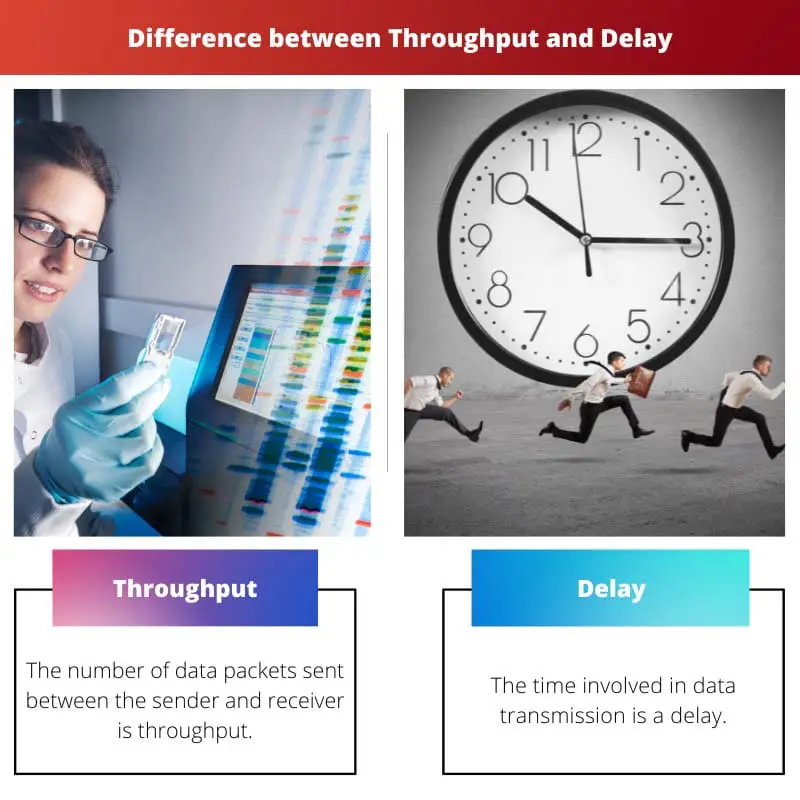Computer networking is a boon in the technology era as networking helps people in transmitting information to their destination in a secure way.
The terms (throughput and delay) are well-known phrases in the networking sector. Both terminologies are distinct from one another in meanings but are interrelated.
Throughput is associated with the quantity of transferred data in a set time. However, a delay means the time necessary to send information to the receiver.
Key Takeaways
- Throughput measures the rate data is successfully transmitted through a network or system.
- Delay, or latency, refers to the time it takes for a data packet to travel from its source to its destination.
- High throughput and low delay are desired for optimal network performance, but they can sometimes be at odds.
Throughput vs Delay
Throughput refers to the amount of data that is sent from sender to receiver at a given time. Throughput is measured in bits per second (bps). Delay refers to the amount of time taken by the data to be transmitted from a sender to a receiver. It is measured in seconds, and it has four types.

The term throughout means the quantity of data sent from the sender to the receiver at a particular time. An instantaneous throughput means transferring the data at the decided time.
However, average throughout means the data takes longer to transmit than expected. Moreover, throughput technology works in real-time (it provides a piece of practical information about transmission.
The term delay is concerned with the time taken to send and receive the data. Delay can be measured in four ways (transmission delay, propagation delay, queuing delay, and processing delay).
It can be expressed as a two-way transmission. However, in a few scenarios, it is measured as time consumed in one-way transmission
Comparison Table
| Parameters of Comparison | Throughput | Delay |
|---|---|---|
| Definition | The number of data packets sent between the sender and receiver is throughput. | The time involved in data transmission is a delay. |
| Type | The throughput can be instantaneous and average. | The delay is categorized into transmission delay, propagation delay, queueing delay, and processing delay. |
| Measured In | The throughput is measured in bits per second or megabits per second. | The delay can be measured by software tools such as ping, and trace routers. |
| Measures | Throughput assists in calculating the performance in the networking world (RAM, disc, etcetera). | The delay aids in determining the transmission speed (how quickly receiver and sender receive the response). |
| Applications | The concept of throughput is applicable in banking systems while making transactions. | Delay is a concept that can be applied to mailing, conveying communications, and even gaming systems. |
What is Throughput?
The term throughput is a vital part of the networking system. While data is transmitted from the starting point to the destination point, a few or many mediums are between them.
So, throughput refers to the total rate of bits transferred between starting and endpoints. Each medium present between the sender and receiver may or may not transport a different quantity of data per second.
For Example,
There are three mediums for carrying data from starting point A to endpoint B. The first medium transmits M1 bits per second. However, the second and third medium transports the M2 and M3 bits per second.
Since the quantity of data transmitted by All three mediums differs, throughput will inform us about the total data sent per second in real-time, depending on the size of the medium.
Supposedly, M3 is the largest medium than M1 and M2, so the throughput is determined based on the bit rate of M3. This method is known as end-to-end average throughput.
We can say the method throughput depends on the sender, the processing rate of the medium, and how active the recipient is. Throughput is advantageous in transmission sectors such as parcel, message, email, etc.
The throughput is directly proportional to the availability of the network. The higher the throughput rate, the higher the network quality. In the same way, the lower the throughput, the lower the quality.
What is Delay?
The term delay refers to the time it takes for data to travel from sender to receiver and back to sender. It is calculated to acknowledge different aspects during data transmission. One of them is network latency.
It means when the network of sender and receiver differs in speed and quality. Delay is calculated based on networking speed. It includes the network speed and quantity of the mediums between the two ends.
The lesser the transmission rate of the mediums, the greater will be the delay. The higher the transmission rate, the lower the delay.
Theoretically, delay can be of 4 types.
The first is the transmission delay. It means the latency while transporting the data. The delay depends on the packet’s size and the capacity of the medium.
The other type is propagation delay. This delay is the time between reaching the data from the last medium to the receiver.
Propagation delay depends on the distance between the last medium and the receiver. It also depends on the rate of transmission. The next type of delay is a queueing delay.
It signifies when a packet waits in a queue before being processed by the recipient. Moreover, we cannot calculate queuing delay. The last delay is the processing delay. It means latency occurs at the time of processing. It also cannot be calibrated.
Main Differences Between Throughput and Delay
- The word throughput means total bits of data travelling from sender to receiver per second. On the other hand, the term delay means latency while transmitting the data between sender and receiver.
- The word throughput is calculated as bits travelled every single second. On the contrary, a delay is measured by time-tracking software.
- The phrase throughput is measured based on instant action or in the form of average throughput. However, a delay can be measured while transporting, propagating, queueing, and processing.
- The action throughput is for measuring how much money is transacted per second. On the contrary, the term delay is used to calculate how much time it took to reach mails, messages, etcetera from the sender to the receiver, along with processing.
- The phrase throughput calibrates the quantity of data, and delay calculates the time involved in transmission.

- https://ieeexplore.ieee.org/abstract/document/4106131/
- https://ieeexplore.ieee.org/abstract/document/5779126/
